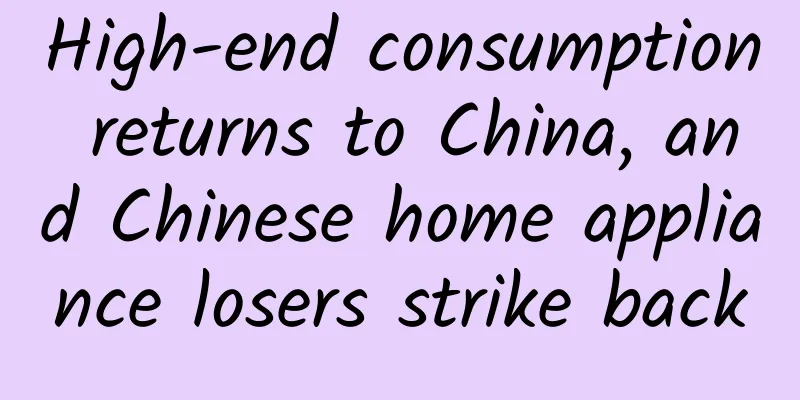High-end consumption returns to China, and Chinese home appliance losers strike back

|
With the emergence of a new round of "return to the domestic market" in the high-end consumer market, it is undoubtedly good news for the Chinese home appliance industry, which is currently struggling in the low-end quagmire. However, how to seize this round of enthusiasm is a 50-50 opportunity and challenge for many Chinese home appliance companies. "What gift should I give my girlfriend on Valentine's Day, under 200 yuan?" someone asked on Weibo. "Why not give her freedom?" This is the answer with the most likes and reposts. Now, giving gifts under 200 yuan on Valentine's Day has been "despised". August 28th is the traditional Chinese Valentine's Day. Buying gifts or going out for a meal as before is no longer popular, and booking a hotel for the holiday has become a popular choice for couples. And those born after 1990 have become the main consumers of high-star hotels and other products. Don’t think that post-90s consumers don’t have money and don’t dare to spend big. Even Morgan Stanley analyst Kimberly Greenberg said in an interview about the consumption behavior of millennials, “I think this huge change will cause serious psychological damage to us.” A report titled "Luxury Consumption Trends in the New Retail Era" was recently released, which contains many interesting findings. For the Chinese home appliance industry, which is struggling in the quagmire of the low-end market, this is undoubtedly a new world. There is a wave of high-end consumption returning to China More and more consumers choose to buy luxury goods in the mainland rather than traveling abroad or purchasing through purchasing agents. The above report stated that China's luxury consumption has reached a "turning point", and more than 600 billion yuan of overseas consumption is flowing back to online consumption platforms on a large scale. The proportion of online consumption in China's total luxury consumption has continued to rise sharply. By 2021, this proportion will reach 13%. KPMG even predicts that by 2020, half of China's domestic luxury consumption will be generated online. Therefore, in the past four years, global luxury brands have lost their arrogance and have increasingly joined Chinese e-commerce platforms such as Tmall and JD.com, especially those luxury brands that have not entered the Chinese market before, taking this as the first step to open up the Chinese market. To better attract luxury brands, Alibaba launched the Luxury Channel, a platform dedicated to inviting high-end top brands, and JD.com also established a "white glove" delivery service, where the deliverymen wear black suits, gray bow ties and white gloves. On the eve of Chinese Valentine's Day, LOEWE, a luxury brand under LVMH, reached an exclusive cooperation with Tmall and customized the Chinese market to design the Chinese Valentine's Day Barcelona handbag, priced at 15,900 yuan, and pre-orders were hot. At 9 am on the 13th, Chloé released 85 limited edition Chinese Valentine's Day handbags in cooperation with Mr. Bags on its official WeChat account, priced at 18,500 yuan, and sold out within half an hour. Which Chinese or foreign brand would ignore this kind of high-end consumption power? The consumption boom of luxury goods in the Chinese market has objectively created a good external market atmosphere for the sales of high-end products, including high-end home appliances. In this atmosphere, the habit of high-end consumption will be gradually cultivated and will extend from the first and second-tier markets to the third and fourth-tier markets. Because more and more consumers born in the 1980s and 1990s, regardless of urban or rural areas, have begun to appreciate the charm of products in terms of craftsmanship, design, service, experience, etc., and they will ignore price cuts and discounts as long as they don't like the product. Therefore, for home appliance companies, high-end transformation or launching high-end sub-brands is no longer just talk or small-scale testing as before, but requires detailed research on market trends and consumer behavior, and drastic actions, because the high-end consumer market has already arrived "in earnest". High-end consumption in county and town markets explodes Although the first- and second-tier city markets are still trend leaders and high-end strategic strongholds, the high-end consumption and monetization capabilities of the third- and fourth-tier county and town markets are also astonishing. From the above luxury goods report, we can see that the spending power of users in the county market for luxury goods has exceeded that of first- and second-tier cities. The unit price of luxury goods consumption has increased year by year, and the unit price of consumers in third- to sixth-tier cities has exceeded that of consumers in first- and second-tier cities in 2015. The top ten cities with the fastest growth in online luxury goods consumption are almost all third- to sixth-tier cities, among which Neijiang, Guiyang and Qamdo are ranked in the top three, and the growth rate of Neijiang has exceeded 300%. For example, LAMER cream, owned by Estee Lauder Group, is using e-commerce to expand into lower-tier cities and cities without specialty counters. This brand, which sells "luxury cream" for thousands of yuan, is also popular in second- and third-tier cities. From a consumer psychology perspective, when users are used to spending tens of thousands of yuan on a small bag, it will be more natural for them to be willing to spend tens of thousands of yuan on large household appliances such as air conditioners, refrigerators, and washing machines. Interestingly, diversified consumer behavior is becoming more and more obvious. Even in first- and second-tier cities, different urban populations have special preferences for brands. In terms of bag brand preferences, Beijing consumers love Chanel the most, Shanghai loves Loewe the most, Guangdong loves Miu Miu the most, and Zhejiang loves Dior the most. Therefore, consulting firm LEK recommends that retailers should not segment target groups based on age, but rather consumer behavior. However, for any company in this era, it is crucial to first understand what consumers really need. For home appliance companies, the biggest impact is to quickly shift from the past standard of "one, two, three, and four-level market division" to market layout based on user groups such as those born in the 1970s, 1980s, and 1990s. What is the most important lifeline? LEK pointed out in the report that only by "thinking smaller" can enterprises "do bigger". This "small" means that the brand promise of enterprises should be directly and accurately oriented to the target customer groups; the products of enterprises should meet the needs of users in detail; the product distribution and brand value proposition of enterprises must be carried out through effective channels. For example, Tory Burch, an American fashion lifestyle brand, has been sharing her understanding of the brand spirit and her lifestyle with the brand audience through social media since its establishment. Moreover, for the opening of each new store and the cooperation with all high-end retailers, Tory Burch will make careful plans based on the operating data. Now, Tory Burch has become another luxury brand with great potential after Michael Kors. Therefore, every link of home appliance companies, including brands, products, experience, and channels, must be adjusted according to the existing changes. Although consumption paths and behaviors are becoming more transparent and reliable, the differences between different generations are becoming more and more obvious. Even the same generation will form different circles, so it is more important than ever to find out what the specific needs of these consumers are. In the future, personalized customization and service are bound to become more and more critical, which is greatly testing the insight of home appliance companies into demand and their ability to quickly meet demand. Of course, the so-called personalized customization is not "one-to-one" customization, but rather changing the past one product to target the world, to several or dozens of products to accurately cover different groups. As a winner of Toutiao's Qingyun Plan and Baijiahao's Bai+ Plan, the 2019 Baidu Digital Author of the Year, the Baijiahao's Most Popular Author in the Technology Field, the 2019 Sogou Technology and Culture Author, and the 2021 Baijiahao Quarterly Influential Creator, he has won many awards, including the 2013 Sohu Best Industry Media Person, the 2015 China New Media Entrepreneurship Competition Beijing Third Place, the 2015 Guangmang Experience Award, the 2015 China New Media Entrepreneurship Competition Finals Third Place, and the 2018 Baidu Dynamic Annual Powerful Celebrity. |
<<: Baidu and Volvo jointly build L4 self-driving car Apollo to practice "safety" as its mission
Recommend
More than 500 experts participate in the App Store review process; less than 1% of rejected developers file an appeal
As the Epic Games vs. Apple court case progresses...
If you suddenly stand up and feel dizzy, don't take it lightly, it may be a sign of illness.
If you stand up suddenly after squatting, you may...
The moon's orbital speed is much lower than the first cosmic speed, so why doesn't it fall from the sky?
This is in response to a question from a netizen....
How to make others find your information on Baidu by searching keywords in Moments?
How to let others search for your website through...
There was more than one "murderer" who caused the extinction of dinosaurs, and new evidence has emerged recently
In the long history of the Earth's evolution,...
How to write marketing promotion soft articles? Sharing ten thousand words of useful information!
Note: This article is about 14,000 words long and...
The State Administration of Radio, Film and Television shot a blockbuster advertisement! ! !
Legend has it that there is such a mysterious org...
Toyota Motor Financial Report: Toyota's net profit in Q3 of fiscal year 2024 was 573.7 billion yen, a year-on-year decrease of 55%
Japanese automaker Toyota said on Monday its prof...
Beware! "Meihua" strengthens to strong typhoon level, with maximum wind force 14! Bringing heavy rain!
Pay attention!!! Typhoon Meihua strengthens to se...
Do you know the "holy grail reaction" in chemistry?
Produced by: Science Popularization China Author:...
Doing math problems just for fun? A review of some of the most famous “useless” mathematical studies in history
Editor’s Note: In the 2024 "Ali Mathematics ...
WeChat's write-while-translate feature is now available: hidden entry, supports translation between multiple languages
Some time ago, WeChat was updated on both Android...
Xiaohongshu promotion method: How to promote effectively?
When you have a fan "offline", and he s...
Android-Super simple to achieve picture rounded corners
I've been troubled by image rounding recently...
Product Manager 90-Day Practical Course 31
What will I gain from joining the “Product Manage...









